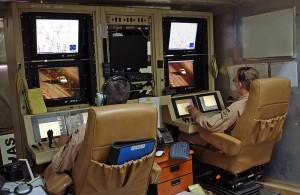Key aspects of George W. Bush’s post-9/11 “war on terror” are finally winding down: U.S. troops have left Iraq and are leaving Afghanistan, but the troubling issue of lethal drones remains and it is time for Congress to set new limits, says ex-CIA analyst Paul R. Pillar.
By Paul R. Pillar
If the American people’s representatives in the U.S. Congress are looking for more productive ways to spend their time, one subject on which they could do useful work is reform of the legal basis for the use of force in the name of counterterrorism. The conceptual and legal foundation for lethal U.S. counterterrorist operations has had serious problems for some time.
The problems extend at least through the past two presidential administrations, but in some respects are even older. Fuzziness remains to this day about exactly to what extent the Clinton administration authorized the use of lethal force in any encounter with Osama bin Laden.

Done “pilots” launch an MQ-1 Predator unmanned aerial vehicle for a raid in the Middle East. (U.S. military photo)
In brief, what is still lacking is a consistent and logical set of rules about how and when lethal force can be used against suspected terrorists, rules that set clear limits while also matching up any permitted use of force with those cases where such use would be necessary and effective.
Two recent developments highlight the problems involved. One concerns a falling-out between the core Al Qaeda organization and ISIS, the Islamic State in Iraq and Al Shams (sometimes rendered as the Islamic State in Iraq and Syria), an extremist group active in the Syrian civil war.
This split has led U.S. officials to discuss whether action against ISIS could be taken under the authorization for the use of military force that Congress enacted shortly after 9/11 and that supposedly is limited to Al Qaeda and its affiliates. But whatever threat ISIS poses, including any threat to U.S. interests, has little or nothing to do with the state of its relationship with Ayman al-Zawahiri’s Al Qaeda.
The other development is the reported consideration being given to the use of force against another U.S. citizen believed to be participating in terrorist activity overseas. Where distinctions are to be made between citizens and non-citizens in such matters is still not firmly resolved, but there ought to be some such distinctions, consistent with citizens having rights in other circumstances that non-citizens do not share.
This issue has gotten further complicated by becoming entangled with a question of which agency of government should be firing missiles from unmanned aircraft. There seems to be a preference for having armed forces pull the trigger if U.S. citizens are involved, but the military also is limited to certain geographic areas when it involved in active warfare.
There are no school solutions to these questions. There are good reasons, for example, both to turn all drone operations over to the military and to limit geographically where the U.S. military is permitted to operate, even though these two objectives may conflict in individual cases. The difficulties in defining the targets for a new authorization for the use of military force (AUMF) reflect the inherently diffuse and ill-defined organizational structure of even just the radical Sunni portion of international terrorism today.
President Barack Obama made a praiseworthy effort in a speech last spring to lend insight and clarity to the U.S. posture on counterterrorism. Among other things, he said he wanted to work with Congress to “refine and ultimately repeal” the current AUMF stemming from the days immediately after 9/11. It is proper for the administration to look to Congress to take center stage in these efforts.
There are fundamental questions at stake about the priority to be given to counterterrorism vs. other objectives, about the criteria for the taking of a human life, and about the meaning and implications of U.S. citizenship.
A congressional lead also would have the advantage of imparting a broader perspective to the overall reliance on drones to kill people, and of separating the construction of policy principles from the execution of the policy. There are too many signs that the drone program has acquired a life of its own, acquiesced in by officials who believe they have no other way to demonstrate immediate action on behalf of counterterrorism, regardless of what may ultimately be greater negative, albeit not immediate, effects.
Crafting new policy on this subject will not be easy. Some of what has already been done and said in the United States in previous years has made it all the harder. Probably the biggest mistake in the past was insistence on using the war metaphor to describe counterterrorism.
This led to the mistaken assumption that the target is a single coherent entity. It also encouraged the excessive militarization of counterterrorism, which today makes drone strikes sometimes seem like the only game in town.
Paul R. Pillar, in his 28 years at the Central Intelligence Agency, rose to be one of the agency’s top analysts. He is now a visiting professor at Georgetown University for security studies. (This article first appeared as a blog post at The National Interest’s Web site. Reprinted with author’s permission.)
